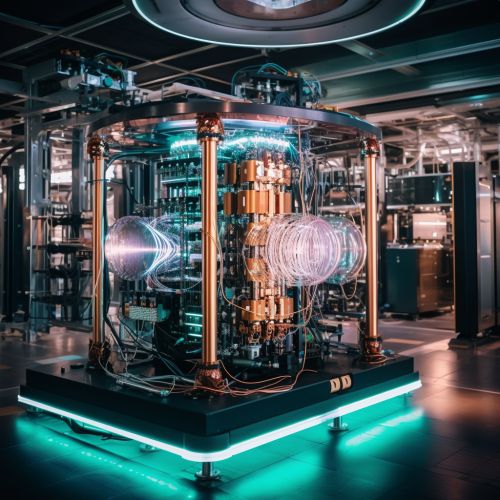Advances in Quantum Computing with Single Photons
Introduction
Quantum computing represents a significant leap forward in the field of information processing, with potential applications in a variety of sectors including cryptography, optimization, and drug discovery. One of the key components of a quantum computer is the quantum bit, or qubit, which can exist in a superposition of states, allowing for a vast increase in computational power compared to classical bits. Single-photon sources are a promising candidate for the realization of qubits, due to their inherent quantum properties and the advances in photon manipulation techniques.


Single-Photon Sources
Single-photon sources are devices that emit photons one at a time. These are crucial for quantum information processing, as they allow for the creation of quantum states of light. Single-photon sources can be broadly classified into two categories: deterministic and probabilistic. Deterministic sources emit a photon on demand, whereas probabilistic sources emit a photon at random times.
Deterministic Single-Photon Sources
Deterministic single-photon sources are highly desirable for quantum computing applications, as they allow for precise control over the quantum states. These sources typically rely on quantum dots, color centers in diamond, or trapped ions. Quantum dots are semiconductor nanostructures that can confine electrons and holes, allowing for the generation of single photons when excited by a laser. Color centers in diamond, such as the nitrogen-vacancy center, can also emit single photons when excited. Trapped ions, on the other hand, can emit single photons due to their atomic transitions.
Probabilistic Single-Photon Sources
Probabilistic single-photon sources, while less controlled than their deterministic counterparts, are still useful for certain quantum computing applications. These sources typically rely on spontaneous parametric down-conversion (SPDC) or four-wave mixing (FWM). In SPDC, a photon is split into two lower-energy photons, one of which can be detected to signal the presence of the other. In FWM, two photons are combined in a nonlinear medium to produce two new photons.
Quantum Computing with Single Photons
Single photons can be used as qubits for quantum computing. The quantum state of a photon can be manipulated using linear optical elements such as beam splitters and phase shifters, allowing for the implementation of quantum gates. These gates can then be combined to form quantum circuits, which can perform complex quantum computations.
Quantum Gates with Single Photons
Quantum gates are the basic building blocks of a quantum computer. These gates operate on qubits, changing their quantum state. For single photons, quantum gates can be realized using linear optical elements. For example, a beam splitter can be used to implement a Hadamard gate, which puts a qubit into a superposition of states. A phase shifter can be used to implement a phase gate, which changes the phase of a qubit.
Quantum Circuits with Single Photons
Quantum circuits are combinations of quantum gates, designed to perform a specific quantum computation. For single photons, quantum circuits can be realized using a combination of beam splitters, phase shifters, and single-photon detectors. These circuits can perform a variety of tasks, from simple quantum algorithms like the Deutsch-Jozsa algorithm to more complex tasks like quantum error correction.
Advances in Quantum Computing with Single Photons
The field of quantum computing with single photons has seen significant advances in recent years. These advances have been driven by improvements in single-photon sources, photon manipulation techniques, and detection methods.
Advances in Single-Photon Sources
Advances in single-photon sources have been crucial for the development of quantum computing with single photons. Recent developments in quantum dot technology have led to the creation of high-quality deterministic single-photon sources, with high photon indistinguishability and low multi-photon emission probability. Similarly, improvements in color center technology have led to the creation of bright, tunable single-photon sources.
Advances in Photon Manipulation Techniques
Photon manipulation techniques are essential for the implementation of quantum gates and circuits. Advances in these techniques have enabled the creation of complex quantum circuits with single photons. For example, the development of integrated photonic circuits, which can manipulate photons on a chip, has allowed for the scaling up of quantum circuits.
Advances in Detection Methods
Detection methods are crucial for the readout of quantum computations. Advances in single-photon detectors have led to improvements in the efficiency and speed of quantum computations. For example, superconducting nanowire single-photon detectors have shown high detection efficiency and low timing jitter, making them ideal for quantum computing applications.
Conclusion
Quantum computing with single photons represents a promising approach to the realization of a scalable quantum computer. Advances in single-photon sources, photon manipulation techniques, and detection methods have brought us closer to this goal. However, there are still many challenges to be overcome, such as the creation of high-quality single-photon sources and the reduction of photon loss in quantum circuits.
